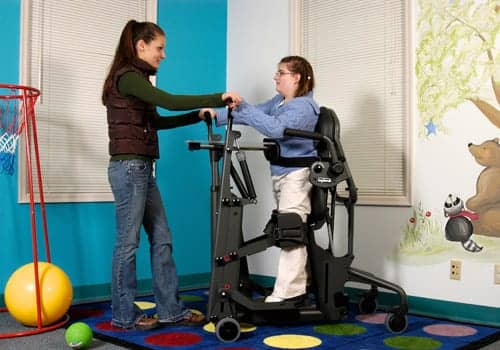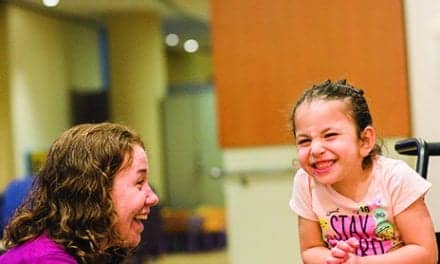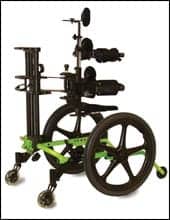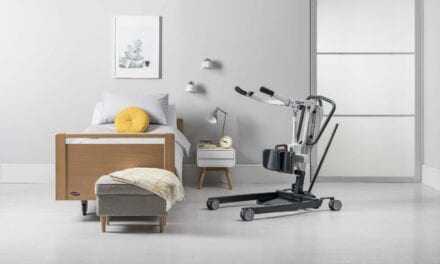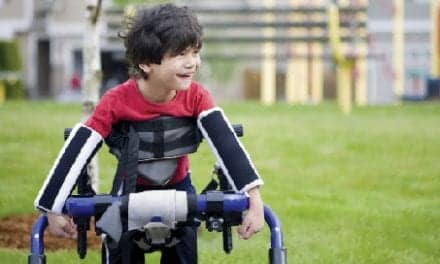Standing programs for individuals with mobility limitations are understood to be beneficial for musculoskeletal, integumentary, cardiopulmonary, and even psychological health.1 There are many devices on the market to allow supported, functional, well-tolerated, and therapeutic standing. In best meeting a client’s needs for a standing system, however, it is vital for therapists to understand the equipment options available, how to evaluate those options relative to the user(s) and setting, and how to optimize that system so the user is fully compliant with a standing program. Among standing systems, there is no one-size-fits-all solution, or a one-size-fits-all-with-this-particular-diagnosis solution. It is the high level of customization standing systems offer, however, that makes them an excellent technology for meeting client needs. Likewise, a device that can include a very wide variety of options can make the selection process challenging. The following information is intended to help guide therapists through this process.
BEGIN WITH MEDICAL NECESSITY
Medically necessary equipment has the capacity to prevent an injury, disease, or symptom from progressing, to decrease pain or discomfort, and to improve function.2 Why is standing necessary for a client? There should be a clear clinical connection between the individual’s diagnosis and accepted standards of practice. Elements to consider for many individuals with mobility-limiting neuromuscular impairment include: range of motion, spasticity, strength, sensory status, pressure areas/pressure sores, bone mineral density, bladder symptoms, bowel symptoms, and cardiopulmonary function.3
Additional medically beneficial justifications may not influence a third-party payor, but are essential in the stander-selection formula. Some of these benefits include increasing the efficiency and ease of functional skills, decreasing pain, decreasing caregiver burden, and contributing to wellness and quality of life. Standing has a positive psychosocial impact, and it is important to weigh meaningful user goals in this domain.4 These are the elements that may be more highly valued by clients and caregivers than the medical benefits, and finding a good fit for maximizing quality is likely to result in greater satisfaction and follow-through with a standing program.
GENERAL CATEGORIES FOR STANDING TECHNOLOGY
Standing systems are classified under the Healthcare Common Procedure Coding System (HCPCS) under four main device categories.
Standing Frame System: This is a one-position stander meant to support the body in a prone, supine, or upright position. The standing angle may be adjusted, but the body remains supported in one plane.
Sit-to-Stand System: The user initiates use of this stander in a seated position, then is able to transition to standing with support in a frame with pivot points that align with hip and knee joint motion.
Multi-Position Standing Frame System: This is a stander that can be converted via moveable parts or accessories to function in a prone or supine configuration based on varying needs of the user.
Mobile Standing Frame System: The base of standers under this category can place the user in a slightly supine, slightly prone, or upright position, or use a sit-to-stand configuration. The user is then able to propel the stander to achieve mobility in an upright position.
Reflecting on therapeutic goals, the level of support necessary for and available to the patient, and being aware of environments in which standing technology is to be used will guide the selection process.
STANDING FRAME SYSTEM
This is a good place to begin. Whether introducing standing for the first time in pediatrics or in hospital rehabilitation, these systems have the least moving parts and allow for standing to be introduced with gradual progression and close monitoring, particularly in a supine configuration. In pediatrics, this stander style is a relatively small size for introducing assistive technology to families, and lightest weight for the early interventionist transporting equipment for lending purposes. Supine standers work well in intensive care units and for individuals with cardiovascular issues who may need to be quickly and safely returned to supine. Supine standers make it easy to monitor multiple lines, ensure minimal pressure on chest and abdomen in the presence of gastrostomy tube, colostomy, or other incision, and monitor blood pressure and airway.
For individuals with dysphagia, reclining 30 to 45 degrees from vertical improves bolus movement and decreases aspiration.5 Standing versus being in a reclined position in a bed or wheelchair minimizes pressure and shear force near the coccyx, the most common site of pressure sores, by redistributing forces to a greater surface area on the posterior of the body and through the legs.
If the fine motor aspect of eating and activities of daily living is challenging, forward positioning up to 15 degrees, easily achieved in a prone stander, has been shown to improve upper extremity function in some populations.6 For those with abnormal reflexes, particularly symmetrical tonic neck reflex, this slightly prone position inhibits extensor tone. Conversely, supine standing decreases flexor tone.
Supine positioning in a standing frame system is preferable for individuals with minimal head control, as gravity can be used to assist in maintaining alignment.
There is potential to stand directly from a bed or chair to an upright or prone stander, which may enable a transfer that requires very little assistance.
Standing frame systems work well for schools and healthcare facilities for multiple users and when caregivers are available for transfers and operation of the equipment. Supine standers are generally higher than standard bed and wheelchair height, so caregivers must be able to manage this transfer for home use. If a mechanical lift is to be used, it is essential to ensure clearance of the lift beneath the stander and to ensure the user’s body clears the surface during transfers.
The best documented therapeutic benefits occur with a program of approximately 60 minutes of standing 5 to 7 days per week. While the supine position has many benefits, and while being upright leads to greater alertness than lying or sitting, standing with a significantly reclined position is not the most functional position.7 If utilizing a supine position, explore use of an adjustable tray to allow support for activity. A clear tray helps prevent creating a visual barrier between user and environment.
Accessories are available on most models to accommodate leg length discrepancies, accommodate plantar flexion, or encourage dorsiflexion, but accommodating flexion contractures at the hip or knee is more effectively accomplished with a sit-to-stand system.
SIT-TO-STAND SYSTEM
For the individual able to perform a seated transfer, this is the best option for maximally independent use, as it may be moved between sitting and standing positions via a user-operated hydraulic pump or electric lift. Sit-to-stand systems also work well for individuals who need more assistance for transfers, and options are available to increase ease of transfer using a mechanical transfer device.
If standing is being used as a therapeutic approach in habilitation or rehabilitation for an individual who is anticipated to progress toward sit-to-stand transitions and gait training, the sit-to-stand system allows for development of motor planning, strength, and performing skill-building without the risk of falling.
The sit-to-stand system is the best option for providing prolonged stretch to joints with limited range of motion. Rather than placing a leg in a knee immobilizer for use of a straight supine, prone, or upright standing system, the limb can be supported at its current end range of motion and supported by the seat at the knee and hip joints for a more anatomically functional prolonged stretch that is easily increased gradually over the course of the standing session and potentially longitudinally over the course of the standing program. This also allows the amount of stretch to be easily altered due to limited tolerance of the position without needing to remove supports from the user or standing frame. Footplates on this model are also adjustable to accommodate leg length discrepancy and ankle position.
If an individual needs to take breaks from standing, but is anticipated to resume standing, a sit-to-stand stander allows for standing to be interrupted, and for the user to remain in a functional seated or partial-standing position while resting.
Varying the amount of skeletal loading has a more positive impact on bone density than static standing alone.8 Performing dynamic trunk and upper extremity activities in the sit-to-stand stander or repeating the sit-to-stand motion can contribute to this loading and unloading effect.
MULTI-POSITION SYSTEM
These standing frames are useful for the patient who benefits from accessing both prone and supine positions depending on therapeutic goals and medical necessity, for instance, if being supine facilitates swallowing, and being prone facilitates use of a communication device. An individual could have varied needs during the course of the day with fluctuations in energy and alertness. A multi-position system also may be the best choice in the instance of neurodegenerative disorders when a longitudinal change in strength and function is anticipated. As is the case with a simpler standing frame system, caregiver support is required for transfers and stander operation. This type of stander may have added value for a school or healthcare facility, as it does offer multiple positions to meet varied patient needs.
MOBILE SYSTEM
Dynamic activity during standing is most effective for maximizing bone density, and is achievable in any style of stander, but occurs most naturally in a mobile system.8
These require a fair amount of upper body strength and control for propulsion. However, due to the relatively large wheel size or the gearing of the drive system, an individual who does not propel a wheelchair functionally may have success propelling a mobile standing frame system. This is an excellent option for maximizing social interaction and participating in activities of daily living. Preschool students can stand side-by-side with peers and move from tabletop activity to easel to sensory table like their classmates. Older students can be at eye level with peers and use more trunk motion and core activation than allowed by their wheelchairs to participate in physical education activities. Adults can move about their environments without having to transfer and sit in a separate mobility device.
OTHER CONSIDERATIONS
The most successful standing program is the one that is implemented. Implementation will rely on ease of use and meaningful functionality. Give careful thought to the types of transfers, locations of transfers, and assistance needed for transfers during the course of an individual’s day. A supine stander may be incorporated naturally and safely for an individual transferring to or from a bed or changing table, or for someone who relies on significant assistance for transfers. Stand pivot transfer or lateral transfer between commode and wheelchair and sit-to-stand stander may become part of the daily routine.
Special consideration should be given to the kind of technology purchased for long-term use in a healthcare or education facility. Will the equipment be assigned to one specific user for a duration of time? Will it be shared by multiple users during the course of 1 day or 1 week? The highly customizable fit of a sit-to-stand stander might be excellent for accommodating a specific individual’s leg length discrepancy or joint contracture, but if equipment is to be shared by people with slightly different needs, a piece of equipment with fewer moving parts may be easier for caregivers or staff to use. Utilize input from the people who provide daily support for the individual or individuals who will be using a standing frame. They may have insight you never considered relative to the environments and activities where standing may be best incorporated. When possible, trial the equipment in these environments and involve caregivers in the selection process to give them ownership of the standing program before it officially begins. It may lead to greater appreciation and compliance once the purchased equipment is in place.
ASSISTIVE TECHNOLOGY PROFESSIONALS
Usually, there are opportunities to “try before you buy,” and third-party payors have an expectation that patients and caregivers have had access to demonstration equipment in natural environments when possible to determine which stander best meets client needs for health and function. Establish a relationship with an assistive technology professional (ATP) who is knowledgeable and responsive. They will be able to listen to the therapist explain a patient’s medical history, abilities, and functional needs, and partner with the therapist in selecting appropriate standing technology. Manufacturers should also welcome inquiries from therapists, answer their questions, and try to connect them and their preferred ATP with a resource who can provide more in-depth information about a particular product.
Stand confident in your understanding of patient function and priorities and be willing to experience stander selection as a process and learning opportunity for all involved. Then stand ready for positive outcomes. RM
Stephenie Labandz, PT, DPT, received her MPT and DPT degrees from the College of St. Catherine in St Paul, Minn. She has written articles about standing featured in multiple national publications. Her passions for neurological rehabilitation and assistive technology have been fed by work experience in a Level I Trauma Center with on-site acute rehabilitation unit and with Robbinsdale Area Schools in her current position in the district’s Early Intervention and Early Childhood Special Education programs. For more information, contact [email protected].

